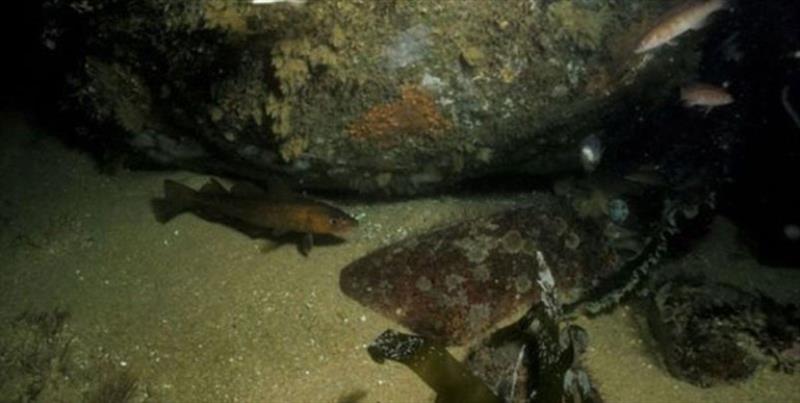
New habitat protections for young cod
by Alison Verkade, Habitat Conservation Division 22 Mar 2018 07:25 PDT

A small cod shelters near a boulder on the seafloor © Long Island Sound Resource Center
For New Englanders, Atlantic cod is not just a fish. The nearly five-foot carved Sacred Cod that hangs in the Massachusetts State House is testament to the cod's place in our culture and history. But, in recent years, Atlantic cod stocks in our region have declined dramatically. In order to bring them back, we have to protect not only the fish, but their habitats as well.
NOAA Fisheries works with regional fishery management councils to identify "Essential Fish Habitat" for all the species of fish that we manage. These areas are necessary for fish to breed, grow, feed, and develop and get special attention under the Magnuson-Stevens Act. As part of the Omnibus Habitat amendment developed by the New England Fishery Management Council, we recently designated a new Habitat Areas of Particular Concern for juvenile cod that went into effect January 3, 2018.
It's complicated, and young cod like it that way
Young-of-the-year cod like complex habitats. They prefer gravel and cobble bottoms and grow best in eelgrass, but they also use sandy areas next to these habitats when predators are not around. Survival is best in the more structured habitats like gravel, cobble, boulders, and ledges – especially those with attached animals or algae that give cod extra shelter.
Young cod also use habitats that match their size. Young-of-the-year cod are only a few centimeters when they settle in bottom habitats, and only about 15 centimeters by the end of their first growing season. Without the extra attached animals or algae, large scattered cobbles or boulders would not likely provide enough complexity for them. Similarly, areas with engineered rip-rap fill don't have enough variation and complexity for young cod.
Protecting important habitat for the sacred cod
At first glance, the new "Habitat Areas of Particular Concern" (HAPC) for cod appears to cover all coastal waters from Maine to Rhode Island, out to 20 meters in depth. But, the juvenile cod Essential Fish Habitat text description limits the HAPC application to areas of rocky or vegetated habitats, and sandy areas for feeding next to these habitats.
While these habitats are not rare in the Gulf of Maine, they need special protection for three reasons:
- They provide young-of-the-year and year-old cod shelter from predators and important feeding habitat.
- They are particularly sensitive to human activities.
- They are also important habitats for many other fish.
Disturbing Rocky Habitats
While it might seem like rocky habitats would be hard to damage, there are actually a number of human activities that can make them less valuable for young cod. Activities like dredging, pile-driving, bridge or pier building, sand-mining, or shipping can:
- Entirely remove, or flatten and roll the rocks, making the areas less complex
- Fill the crevices with sediment
- Reduce plant growth
- Scrape off the attached animals and algae that provide food and complexity
Any of these activities could reduce the ability of young cod to survive and grow. Recovery of rocky habitats after disturbance is very slow, typically taking decades or more.
NOAA's Role in Habitat Protection
Our role in protecting the Council's designated Habitat Areas of Particular Concern is to review activities that require a federal permit, or are being funded or done by a federal agency. We provide conservation recommendations to our federal partners in order to avoid, minimize, or offset adverse impacts from these activities. The new designations help prioritize these areas for protection, and make sure we focus our recommendations on the most important areas for these fish.